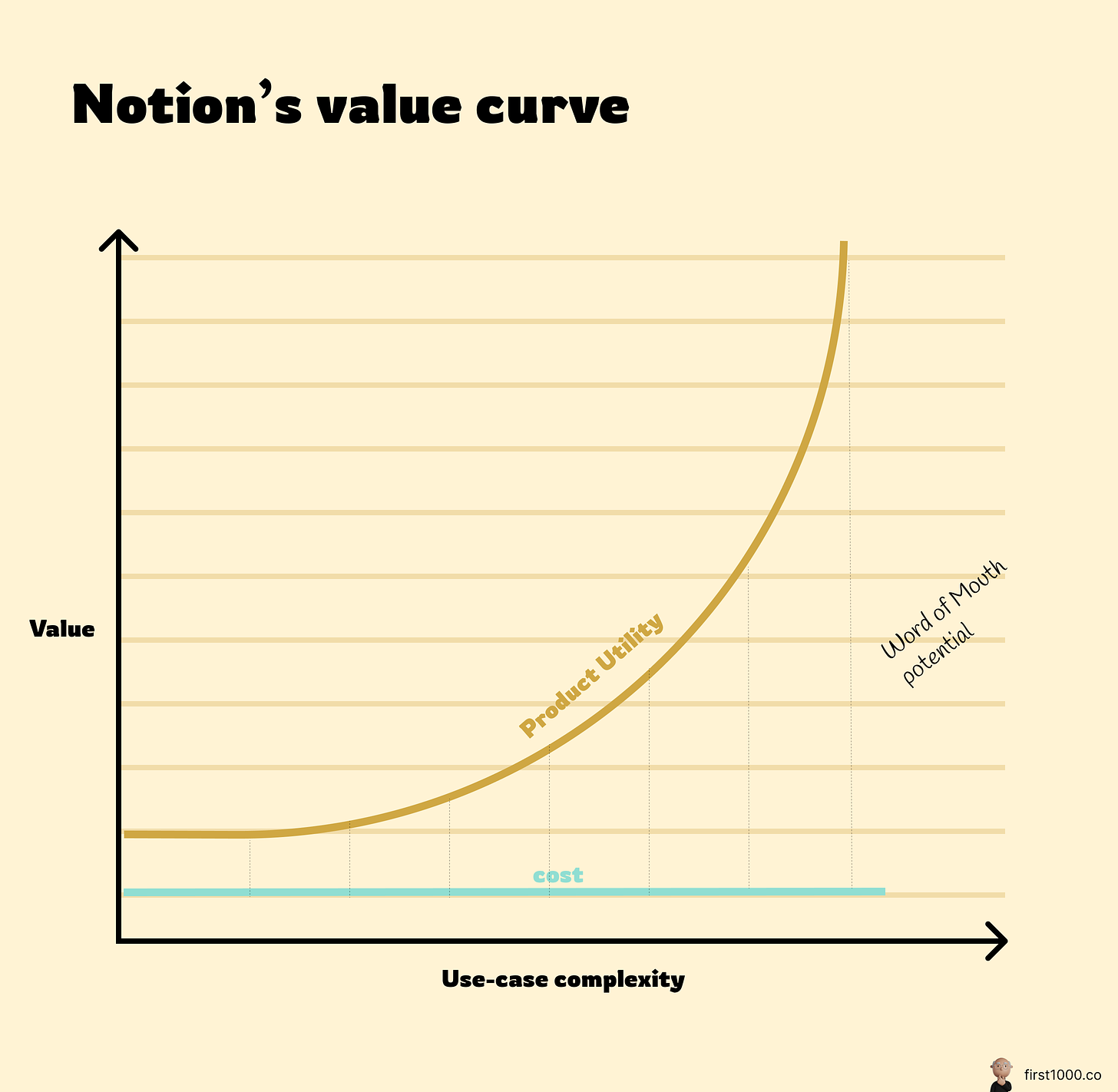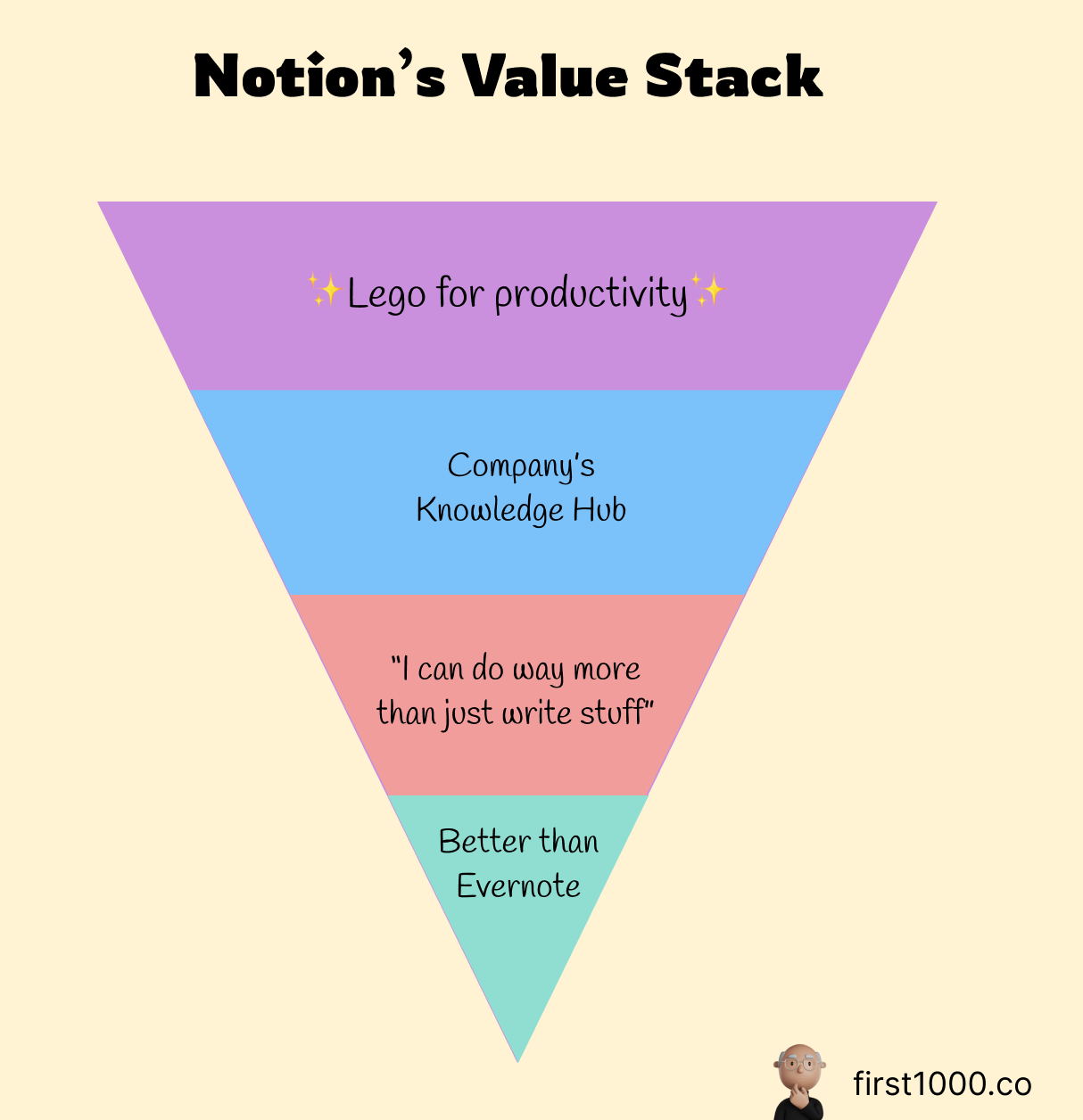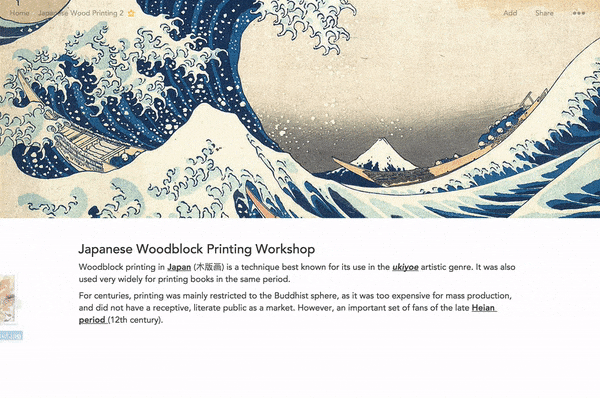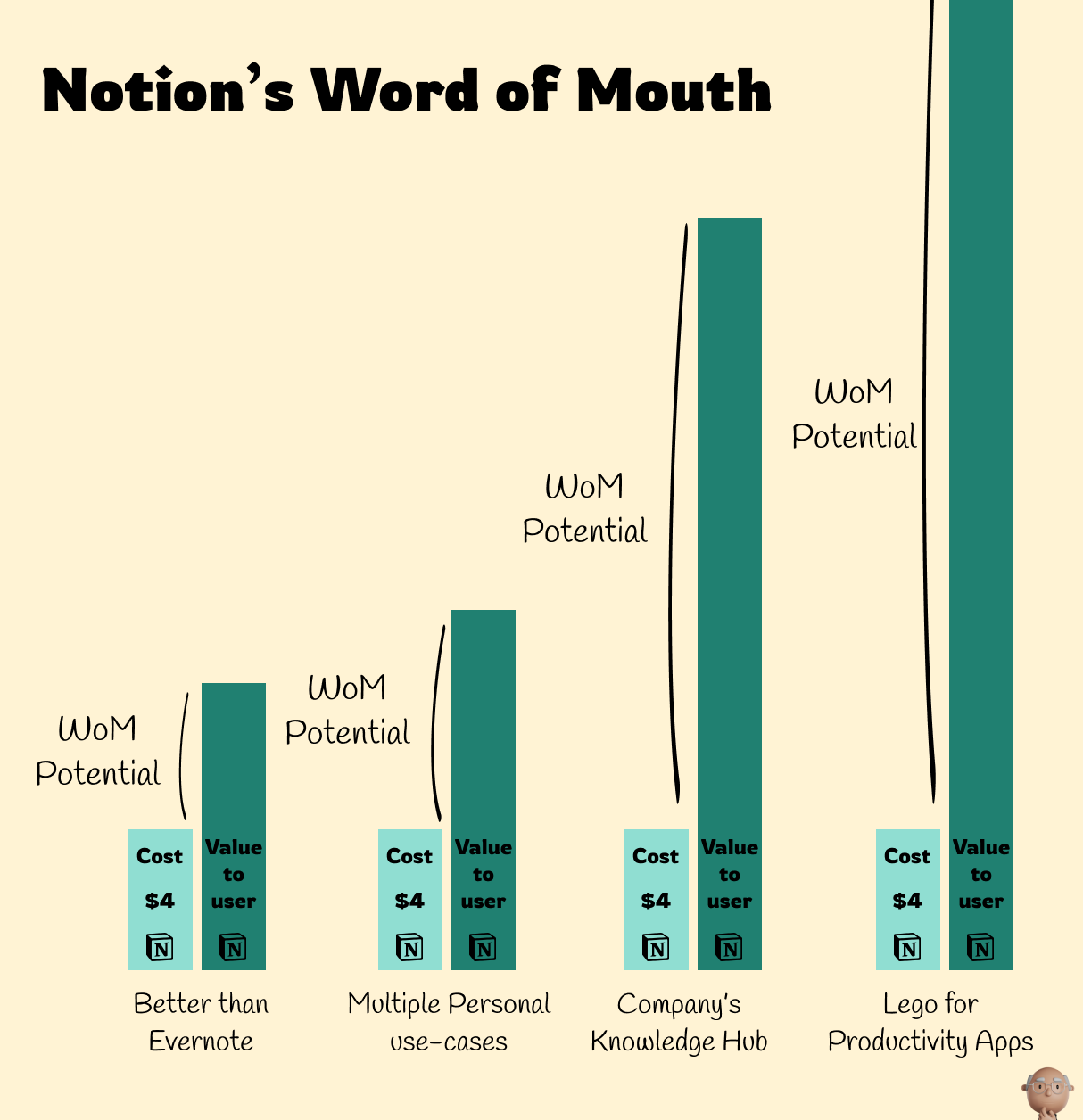✨Notion
+ launching a product in a crowded space, growing through Word of Mouth and positioning a product that is hard to explain!
Hello Frens 👋,
Happy Tuesday! The holiday seasons are almost here and I’m getting in the spirits. Here is a little bit of Jimmy Fallon, a little bit of Ariana Grande, and a little bit of Megan Thee Stallion to bless your holidays!
Before we get to today’s company Notion, I have some exciting news to share. Out there in the world, exists a First 1000 users interactive guide built on top Coda (Notion + Airtable hybrid on steroids).
Shoutout to Trustin Yoon for building a fantastic guide to help scale your own product from 0-1000!
With that out of the way! Let’s jump right into Notion!
—
Notion’s Origin Story
More than a decade ago, in 2011, a young artist Ivan Zhao graduated from one of the top Canadian universities: the University of British Columbia. As a self-taught programmer from a young age, Ivan opted not to get a formal education in programming, choosing to study cognitive science (with a minor in photography) instead.
During those university years, Ivan fluctuated between pursuing a career in academia as a cognitive scientist and one in art photography; wherever Ivan went, so did his Contax T2 camera. He was a creative at heart.
but soon after graduating, Ivan found himself on a 1-page portfolio websites creation spree. Being the only geek in a circle of fashion designers, artists, and creators, he was expected to put his technical talent in the group's service.
Sick of creating 1-page websites, Ivan set his sights on building powerful software that would replace this agonizing task of churning out 1-page websites for his friends. He hoped that said software he was making would unleash the creativity of non-programmers, who had the vision and taste necessary to create self-expressive portfolio websites but lacked the tools to do so.
Ivan quit his job at the digital publishing company, Inkling, and teamed up with Toby Schachman to pursue this mission. Toby, at the time, had just finished his Master’s at NYU, where he published his entire thesis on visual programming.
Visual programming was an elegant solution to the portfolio-creation problem Ivan was so keen on solving. But Ivan and Toby set their eyes on a much more ambitious project! Why stop at building a webpage builder? Why not make a tool to create any generic web app that people can use without learning how to code?
In 2013, they raised some Seed money and were onto the races. Along the journey, they added one more person to the team: Simon Last.
Simon was an aspiring visual programmer. He was still pursuing his bachelor’s at the time and had connected with Toby over their shared passion for creating visual programming projecting.
The two met up, and after a two-hour conversation, Toby convinced Simon to quit his summer internship and join Ivan and himself on their mission to democratize programming for everyone.
The trio set out to build the first experiment to validate the hypothesis of creating a plug-and-play tool to create software. One of the first prototypes they built was Concept. Concept made it easy for people to collaborate live on building web pages.
The history here is a little unclear. But somewhere after the release of Concept that Toby moved on to pursue other projects. Simon & Ivan stayed persevered and found new collaborators in another team working on a similar project.
The team was Chris Prucha and Jessica Lam the creators behind SugarBox. Chris & Jessica met at Apple. The two quit their cushy jobs to build a dead-simple SDK that can turn any website into a collaborative one with one line of code.
One of the first companies to adapt Sugarbox was CodeAcademy.
The problem with Sugarbox, or Concept or the vision of democratizing programming for creative people, was that it was not rooted in any immediate frequent problem that the very same people they targetted (non-programmers) faced. So when Chris, Jessica, Ivan & Simon teamed up, they found it sound to wrap their powerful solution in an everyday average Joe problem creating documents.
Enter Notion.
The work on Notion started in late 2013/early 2014. But, by early 2015 the project was still held at a standstill.
The app was constantly crashing, the real-time collaboration did not work as intended, and the team faced a critical decision. Either start the project from scratch on a new technical foundation or call it quits.
To add salt to injury, the small angel round they had raised two years prior was not going to get them there no matter how far they stretch it! The company was on the verge of bankruptcy with nothing to show for all the teams hard work.
Simon & Ivan made the hard decision to part ways with Chris & Jessica. The duo then moved to Kyoto, Japan, to rebuild the entire application from the ground up. The move to Japan + slimming down the team gave them some runway to give Notion a fighting chance to make it out into the real world.
They sublet their San Francisco apartment and lived off the difference between SF & Kyoto rental costs. Being in a new country— where they did not speak the language and did not know anyone— meant Simon and Ivan could spend all their time programming, designing, thinking, and creating Notion.
In March 2016, almost a year after they hit the reset button on building Notion, Ivan & Simon launched the product on Product Hunt. The launch ended up being to be one most successful ones in 2016! Thousands of people flocked to the Notion website to sign up and try this new product.
The momentum from the launch helped Simon and Ivan raise a small bridge room that gave them some breathing room to build what is now a $10b enterprise!
Today I’ll be exploring how and why the Notion launch was such a success!
Let’s start with why- rationally it wouldn’t be.
Selling a "hard to get" product.
Notion is sort of wiki, sort of Quip with a bit of Trello.
~ Early Notion Adaptor
The first problem a product like Notion has to overcome is explaining exactly what this tool does! Notion's power is derived from its flexibility & adaptability; instead of adjusting your workflow to fit Notion, Notion molds its software to accommodate you & your team. That very same power makes Notion exceedingly challenging to communicate to potential customers. One just “has to try it to get it.”
Notion is not the first company to face this problem. Many have attempted to bundle different factures productivity software under one overarching umbrella. What Notion did differently from its predecessors, however, was to bundle single-player productivity with multiplayer productivity apps.
Let’s take a closer look at different productivity bundling solutions at the time:
Quip: Real-time collaboration on document + Chat
Amium: File sharing + Chat
Bear: Notes + Docs
Notion: Docs + Wiki + Tasks
Notion’s wide-reaching bundle was possible because the product's core was differentiated. The two core product differentiations are:
A Canvas Structure: Notion steps away from the standard paper-like structure of documents and gives users blocks they can mix and match. All while maintaining consistent styling and allowing for seamless collaboration.
Flexibility & Adaptability: The blocks structure of Notion gives users the flexibility to build powerful tools that adapt to their needs rather than the other way round.
These features help make explain why Notion chose Word + Confluence + Trello bundle for their 1.0. This bundle strikes a balance between having a low barrier to enter "low switching cost" for Docs, having a high utility on single+multiplayer (all three), and highlighting the product block-mixing power (differentiation).
On the other hand, Quip, Amuim, Bear, et al. were forced to make a different set of choices. The core value proposition for these bundling solutions was layering in an additional productivity functionality on top of a familiar one. Hence, they had to go all-in Multiplayer utility (e.g., combining chat with file sharing is only useful when you have a meaningful number of team members using said software), making it harder to gain mindshare or go all-in on single-player utility, making it harder to monetize.
Go To Market Strategy
99% of the growth of Notion is Word of Mouth (WoM) driven. Whenever I hear WoM, I think of it as an obscure catch-all phrase that makes a company more appealing to investors.
But in researching this piece, I wanted to understand how exactly Notion grew through Word of mouth? Especially when they didn’t have an established customer base or a following to lean on to kickstart the process.
It came down to a simple two-step process:
Raise Awareness: launch on discovery platforms.
Go viral: get those initial users to spread the Word.
This may sound like a vanilla-abstract strategy, but it isn't.
Awareness: launching on discovery platforms
Think of discovery platforms as places like Designer News, Hacker News, Product Hunt..etc. Websites with high traffic visited by a large number of geeks to find new products.
Every big product debut Notion made on any of these platforms ended up taking a life of its own. By just listing on one platform, they could find an initial set of users that would spread the product across a whole new set of other online communities and so on and so forth.
Take the 2015 v0.5 Product Hunt accidental launch. This was before the team moved to Kyoto and were still building Notion on the wrong tech Stack. An unintentional feature on Product Hunt ended up pouring down into half a dozen other online communities and getting Notion hundreds if not thousands of people knocking on their door to try out the product.
Not every launch on a discovery platform end up having the pour-over effect that Notion had. Why exactly this happened is because they were able to get those initial cohort of people to spread the word.
Virality: getting people to spread the Word.
A product that spreads through WoM is simply a product that people love and want to be associated with! If we believe that to be true, then to get a product to spread through WoM, one ought to
Maximize user commitment to the product (i.e., association)
Maximize the positive emotions (i.e., love) users have while using the product
On the first point, one way to maximize user commitment is by getting them to invest time and effort in learning the ins and outs of the tool at hand. Most enterprise (or even consumer) software has a learning curve. The more you learn how to use the software, the more utility you can extract out of it.
Notion did an excellent job here at moving people along this learning/value curve extremely efficiently (without the need of a large CS or sales force) and extremely fast.
For the same $4,$8,$12/month, Notion is a better bargain for someone on top of the Value curve than someone just at the start, and those are the people who would be most motivated to spread the word about the product.
Moving people along the value curve:
There are infinite possibilities and use cases for Notion; this is the power of being a malleable software. However, for the sake of this research, I bundled them into four levels.
Level 1: Single personal use-case
Level 2: Multiple personal use-cases
Level 3: Company's source of truth
Level 4: Lego blocks for creating productivity apps.
A simplistic yet fun way to think of team-based software as a game. The winner of the game is the person that convinces everyone on their team to play their personal favorite game.
From a company's perspective, in our case, Notion, we established that the goal is to get as many users to the highest-value level ASAP. By doing so, the user would have invested just enough into being a master of this game that they would be a lot more likely to recruit their colleagues to play alongside them rather than attempt to master a whole new game themselves!
But Notion, like any new company getting started, didn't have a magical cohort of people who mastered their software and the block-first architecture. What they had, was a good product sense that maximized the number of people who reached the highest level of the Notion Value Stack.
Let's take a look into what they did there:
Getting users to Level 1
Everything pre-sign-up on Notion is focused on teaching people how to use the product. The end-state is left for the users to imagine. While other more-established productivity software focused exclusively on what to use their product for (i.e., the value proposition of said software).
Once you know how to use Notion, it can be whatever you want it to be. It could be a Wiki, a knowledge hub, a task management tool, a to-do list, and the landing page is optimized to get you to think about what that ideal use-case would be for you by showing you the power of the tool!
Getting users to Level 2
After showing "what they can do." It was time to put some of that learning into action. If Notion's Landing page was about the what, the onboarding process was about the how. Onboarding on Notion was all about showing users how they could use the product.
I could not access the early tutorial, but here are a few samples of early feedback on the onboarding process that reflects just how much effort they put into training people to be Notion Jedis.
"Fantastic onboarding flow! The "wow"-ing feature gifs followed by your interactive tutorial sold me."
"This is the Mother All Demos... Congrats to the team, this is amazingly done!"
"Looks really cool - love the inset video"
"This looks amazing and the onboarding process is really good."
Getting users to Level 3 & Level 4
To get people towards the highest level of the value stack, moving from the personal use-case to the multiplayer one, Notion did a few things.
First was allowing collaborators to bypass the early-access form. If anyone wanted to an invite to Notion, the path of least resistance is to find someone already using it and collaborate on that workspace.
Second was showcasing the power of Notion in a company setting. Releasing Notion’s Product roadmap (built on Notion, of course) was how they did that. The open-sourced roadmap showed "Notion in action" on an enterprise level and highlighted all the new team collaboration features that were just on the horizon.
(If a particular feature was what was holding you back, seeing it is one, two, three weeks away gave people the confidence to adapt Notion for their teams now, knowing they’ll soon be (very well) served.)
The third thing was templates. The Notion v1.0 came with 30 templates team-ready templates that ranged from a design spec template to a knowledge hub one.
—
When looking at all these things they did to move people along the value stack, a couple of things stand out.
The first is how Notion's journey starts with a very simple value-proposition that solves users' immediate problems, then guides people towards "unlocking" more valuable use-cases.
The second is their pricing. Notion is priced off the minimum value the software can deliver. At $8 (later $4 and now free) for personal use, Notion was on par with Evernote, a personal note-taking app. But Notion blows Evernote out of the water on Note-taking alone and is much more powerful & versatile than just a note-taking app.
If the average company replaced 5-6 tools by adapting Notion (that is just my very uneducated guess), then pricing it at $20-$30 would still be a bargain for any enterprise. Yet, with aggressive under-pricing, all the surplus value that users unlock as they build more powerful use-cases feeds directly the company's growth potential through WoM rather than their top line.
Notion's under-pricing, even their lowest-value competitor, makes it almost criminal not to adapt Notion and spread it into the workspace. Imagine working at a small startup that is stitching together Jira, Google Docs & Confluence. They spend $45 / user. With the switch to Notion, they spent $4/user and have all their data consolidated in one place. If no one got fired for buying IBM, then surely no one will get fired for buying Notion and dropping the company's productivity stack costs by 90%+.
The more Notion widened the gap between cost & value, the more invested users became in the product and, in turn, recruited friends, colleagues, and collaborators onto the product.
And this is how the company grew like wildfire through "word of mouth.”
Some Learnings from writing this piece
You can build a very defensible business in a low-barrier-to-enter industry. Position for the low-barrier, gain Awareness and move people along the product value curve to build defensibility.
Sometimes it is best not to communicate your value proposition! Start small and build it, especially if you build a product with a large surface area.
To accelerate Word of mouth, help users extract more value from your product as fast as possible. Each product interaction is an opportunity to unlock the "next" value level.
I'm working on revamping the First 1000 website & the referral program, and it should be ready by the beginning of 2022.
A sad true story is that I measure my self-worth in how many new subscribers each piece gets. Make me feel good about myself this week :(
See you next week 😉,
Ali Abouelatta
*See important disclosures











